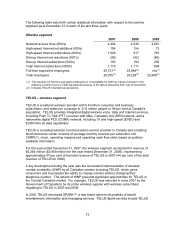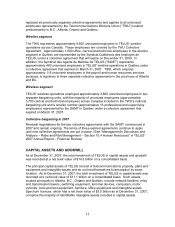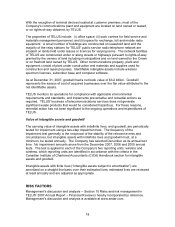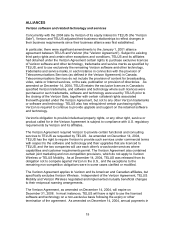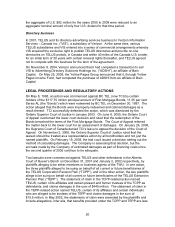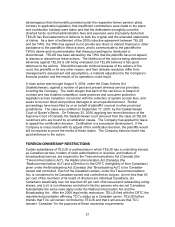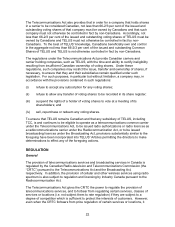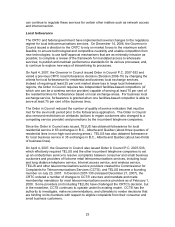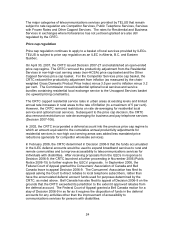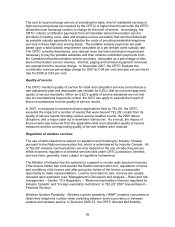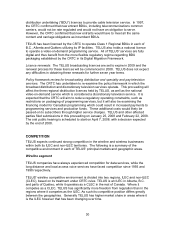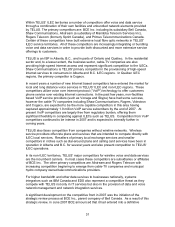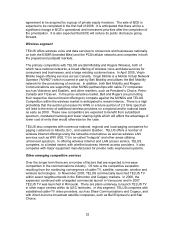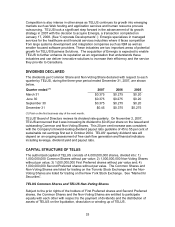Telus 2007 Annual Report Download - page 23
Download and view the complete annual report
Please find page 23 of the 2007 Telus annual report below. You can navigate through the pages in the report by either clicking on the pages listed below, or by using the keyword search tool below to find specific information within the annual report. 23
can continue to regulate these services for certain other matters such as network access
and interconnection.
Local forbearance
The CRTC and federal government have implemented several changes to the regulatory
regime for local telecommunications services. On December 14, 2006, the Governor in
Council issued a direction to the CRTC to rely on market forces to the maximum extent
feasible; to ensure technological and competitive neutrality and enable competition from
new technologies; to use tariff approval mechanisms that are as minimally intrusive as
possible; to complete a review of the framework for mandated access to wholesale
services; to publish and maintain performance standards for its various processes; and,
to continue to explore new ways of streamlining its processes.
On April 4, 2007, the Governor in Council issued Order in Council P.C. 2007-532 and
varied a previous CRTC local forbearance decision (Decision 2006-15) by changing the
criteria for local forbearance for residential and business local exchange services.
Instead of requiring at least 25 per cent market share loss in large local forbearance
regions, the Order in Council requires two independent facilities-based competitors (of
which one can be a wireless service provider) capable of serving at least 75 per cent of
the residential lines for forbearance based on local exchange areas. For business local
exchange service, forbearance is granted when one facilities-based competitor is able to
serve at least 75 per cent of the business lines.
The Order in Council reduced the number of quality of service indicators that must be
met for the six-month period prior to the forbearance application. The Order in Council
also removed restrictions on winbacks (actions to regain customers who changed to a
competing service provider) and promotions by the incumbent telephone companies.
Since the Order in Council was issued, TELUS has obtained forbearance for local
residential service in 63 exchanges in B.C., Alberta and Québec (about three quarters of
residential lines in non-high-cost serving areas). TELUS has also obtained forbearance
for local business service in 35 exchanges in B.C., Alberta and Québec (about two-thirds
of business lines).
On April 4, 2007, the Governor in Council also issued Order in Council P.C. 2007-533,
which effectively required TELUS and the other incumbent telephone companies to set
up an ombudsman service to resolve complaints between consumer and small business
customers and providers of forborne retail telecommunications services, including local
and long distance telephone service, Internet access service, and wireless service.
TELUS and other telecommunications service providers created the Commissioner for
Complaints for Telecommunications Services (CCTS), and TELUS became a founding
member on July 23, 2007. In Decision 2007-130 (released December 21, 2007), the
CRTC ordered a number of changes to CCTS’ structure and mandate and made
membership mandatory for most telecommunications service providers as of February 1,
2008. Some providers (not including TELUS) have challenged the CRTC’s decision, but
in the meantime, CCTS continues to operate under its existing model. CCTS has the
authority to investigate, make recommendations, and ultimately to render decisions that
are binding on its members with respect to eligible complaints from their consumer and
small business customers.




